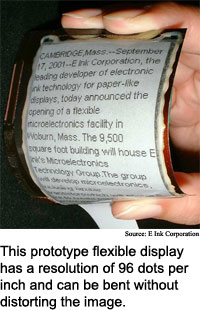
Flexible display slims down
By
Eric Smalley,
Technology Research NewsThe long-running quest to build a computer screen that you can fold up like paper and put in your pocket is a little closer to reality.
Researchers from E Ink Corp. have produced a high-resolution electronic display that is 0.3 millimeters thick -- about four times the thickness of a typical piece of printer paper -- and can be rolled into 4-millimeter cylinder.
The researchers' prototype is a little larger than a business card and has a resolution of 96 dots per inch, which is comparable to today's handheld computer screen resolutions. The screen has an ink-on-paper appearance, a 180-degree viewing angle, and can be bent into a curve 3 centimeters in diameter without affecting the picture, said Yu Chen, a senior engineer at E Ink.
The device could eventually be used in electronic books that are more paper-like that today's tablets, and it paves the way for lightweight screens for wearable computers, said Chen.
There are two major challenges to making electronic displays in a paper-like form, said Chen. The first is developing an electronically controllable ink that has the optical properties of regular ink and can retain its image without any applied power, he said.
The electronic ink used by the researchers' prototype was first demonstrated by Massachusetts Institute of Technology researchers in 1998.
It consists of many tiny capsules of charge-sensitive pigment. The capsules are tens of microns in diameter, said Chen. A red blood cell, in comparison, is 5 microns across. In the researchers' black-and-white prototype, capsules contain both black and white particles of pigment. A negative voltage causes the white particles to move to the surface, and a positive voltage causes the black ones to move to the surface. When the power is off, the pigment stays put.
The second challenge is to to produce a thin, flexible network of electronic circuits that connect every pixel in the display so they can be turned on and off.
The researchers' relatively thin display is a four-layer sandwich of electronic ink capsules, thin-film transistors that switch each capsule on and off, an insulating material and a 75-micron-thick steel-foil substrate, or backing. The researchers used standard photolithography processes, which employ light and chemicals to etch out tiny features, to form transistors in the thin-film layer. They laminated the electronic ink layer on top of the electronics.
The researchers increased the speed, contrast ratio and image stability of the electronic ink by improving the materials and chemistry involved, said Chen. The researchers' device switches pixels between black and white within a quarter of a second, which is considerably slower than a computer screen, but is sufficient for an electronic book page-turn.
The researchers' next steps are to improve the ink switching speed, make the device thinner, and add color, said Chen.
The ink switching speed would have to improve from 250 to 15 milliseconds to be able to support today's computer video applications, said Chen. And to make the device thin enough to be folded like a piece of paper, the thickness of the steel-foil substrate must be reduced to 25 microns, he said.
The device is currently ready for black-and-white applications like electronic readers and smart ID cards. It will probably take several years to develop a full-color display that switches quickly enough to support video and is thin enough to be folded into a pocket, said Chen.
Ultimately, "electronic paper and wearable computer screens... might have a large impact on environmental protection... and how our society distributes information," said Chen. "Just imagine the billions of trees we can save each year."
Chen's research colleagues were Joanna Au, Peter Kazlas, Andrew Ritenour, Holly Gates and Michael McCreary. At the early stages of the prototype's development the researchers also worked with Sigurd Wagner and James Sturm of Princeton University, said Chen.
The work appeared in the May 8, 2003 issue of Nature. The research was funded by E Ink.
Timeline: Now, > 3 years
Funding: Corporate
TRN Categories: Materials Science and Engineering
Story Type: News
Related Elements: Technical paper, "Flexible Active-Matrix Electronic Ink Display," Nature, May 8, 2003.
Advertisements:
May 21/28, 2003
Page One
Hydrogen storage eased
Flexible display slims down
Simulated evolution gets complex
Model explains market movements
News briefs:
Big qubits linked over distance
Software maps group work
Magnesium batteries show mettle
Nanotubes smash length record
DNA sensor changes color
Sensor serves up body slices

News:
Research News Roundup
Research Watch blog
Features:
View from the High Ground Q&A
How It Works
RSS Feeds:
News
Ad links:
Buy an ad link
| Advertisements:
|
 |
Ad links: Clear History
Buy an ad link
|
TRN
Newswire and Headline Feeds for Web sites
|
© Copyright Technology Research News, LLC 2000-2006. All rights reserved.